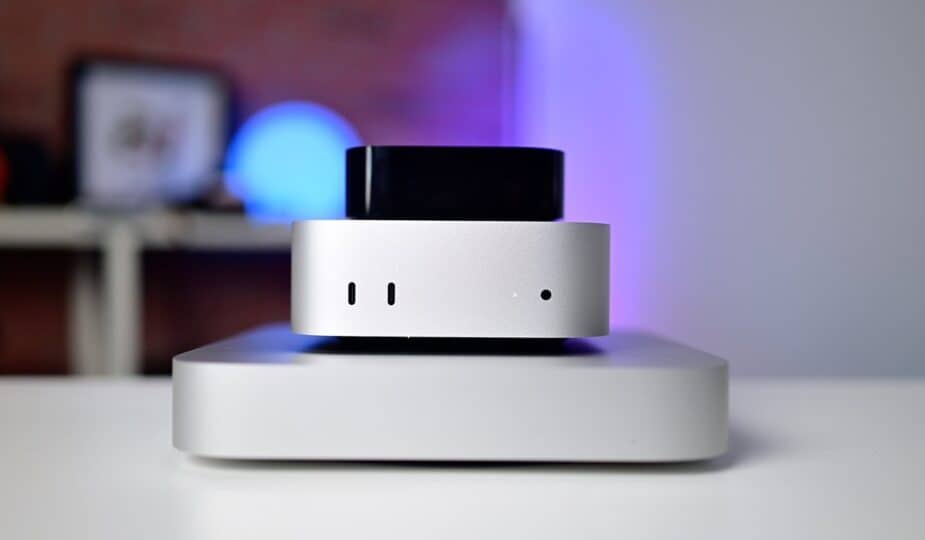M4 Mac mini [center] between old Mac mini [bottom] and Apple TV [top]
 4 Facebook x.com Reddit
4 Facebook x.com Reddit
Apple executives said the new M4 Mac mini design could be even less acclaimed, but to create a better version English: a number of compromises had to be made.
Apple’s refresh of the Mac mini with the M4 and M4 Pro chips resulted in a much more compact design with few physical changes. In addition to the size, the ports were also moved to the front, and the power button was mounted on the bottom.
Talking to Fast Company about the redesign, Apple’s vice president of hardware engineering Kate Bergeron and Mac marketing specialist Sophie Le Guen explained that it was a balancing act.
“The Mac mini holds a special place in our hearts,” Bergeron said. “This product is an incredibly important part of the Mac lineup, and we didn’t want to do it a disservice by not taking the time we needed to make it great.”
Comparing it to a three-legged stool that needed to change in several areas at once to maintain balance, Bergeron suggests that the needs of Apple Silicon were the first consideration. The team first asked what kind of Mac mini they needed to optimize around Apple Silicon, while also balancing user performance and design expectations.
Not too small
Initially, the designers brought in “something that was probably too small to get what we wanted,” Bergeron says, based on expectations that the Mac mini would be both small and versatile. “But it’s their job to challenge us in the physical space.”
The inclusion of an M4 Pro variant meant the design had to incorporate improved cooling, which also took acoustic considerations into account. “We probably could have been even more aggressive [with the smaller Mac mini] if we had decided to design just for the M4,” Bergeron admits, adding that it was important to design for pro customers, too.
The VP continued, “We need to combine all of those [considerations] together and have a lot of conversations with the design team to figure out where we land.”
Port Placement
The talks also included the opportunity to change the port layout, moving away from the usual rear-only port layout. Le Guen cited two main reasons for the change.
The first was the Mac Studio, considered a design success and the first Mac desktop to use front-facing ports since the 2012 Mac Pro. The other was user feedback.
Some people wanted to change the orientation of the device so they could easily access each of the [rear] USB ports,” Le Guen emphasizes. “That led to [us] saying, ‘Let’s listen to users and make sure we’re offering the convenience they’re looking for.’”
While users had been asking for the ability to upgrade storage, the modular version in the new Mac mini actually serves a different purpose. The modular storage was meant to help create “manufacturing flexibility,” Bergeron said.
The tight limitations of the Mac mini’s internal components mean that “there’s not enough room on the main logic board to put storage directly on the board” for larger storage configurations, Bergeron explains.
As for the placement of the power button on the bottom, that was also a design compromise. Bergeron defends the placement because it provides “pretty good access” to the button, and because users often put their Macs to sleep, “the power button is used very rarely.”
“We thought the versatility of having all of these [new front USB ports] was really [more] important.”
Environmental Innovation
This model is Apple’s first carbon-neutral Mac, and it also uses a lot of recycled metals. In addition to using 100% recycled zinc and recycled copper in the internal components, and 80% recycled steel for the Apple logo for the first time, there have also been big changes in the manufacturing of the case.
The case is made from extruded aluminum, like earlier models, which is cut to length. Previously, it was cut with a 3-millimeter-thick production saw, which resulted in unusable shavings of about the same thickness.
To minimize these shavings, a new cutting system was created using diamond-coated nylon wire that is a fraction of a millimeter thick. This change saved more material rather than wasting it as shavings.
Long-term changes?
As for the future of the model, the couple, as usual, are unwilling to comment on the product roadmap. But Bergeron hopes the design will be relevant for a long time, just like the previous version.
“We wanted to make sure that we were delivering value to customers for many years to come. And we'll see where the vision takes us next.”
Follow AppleInsider on Google News










